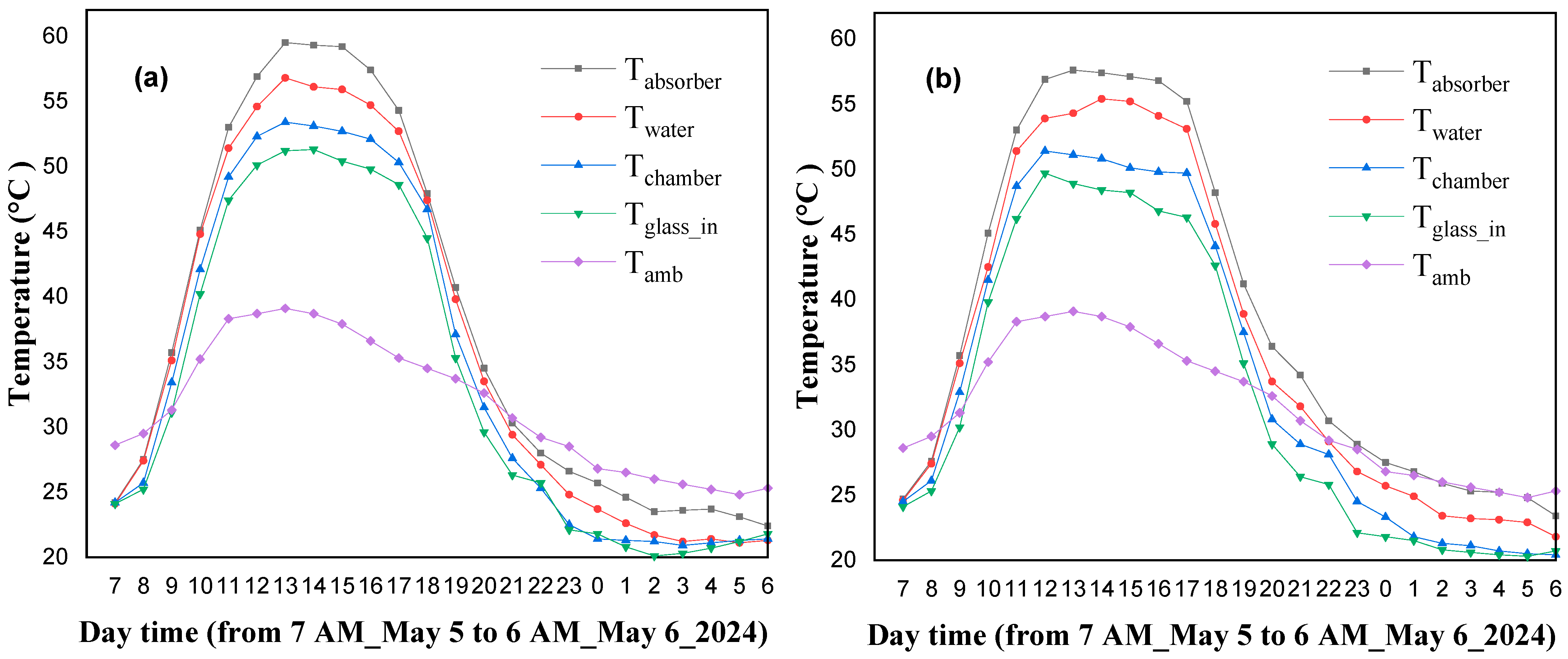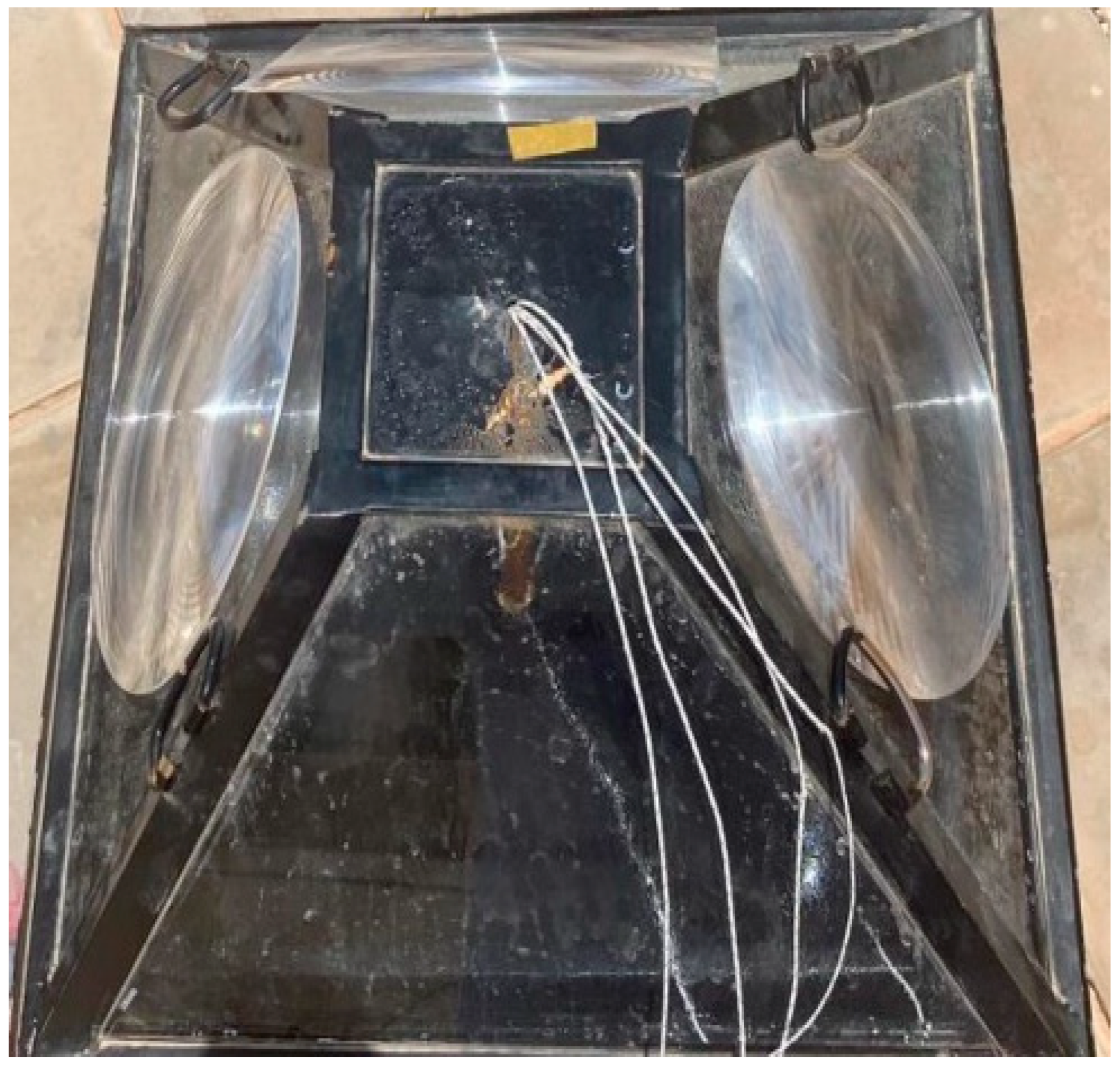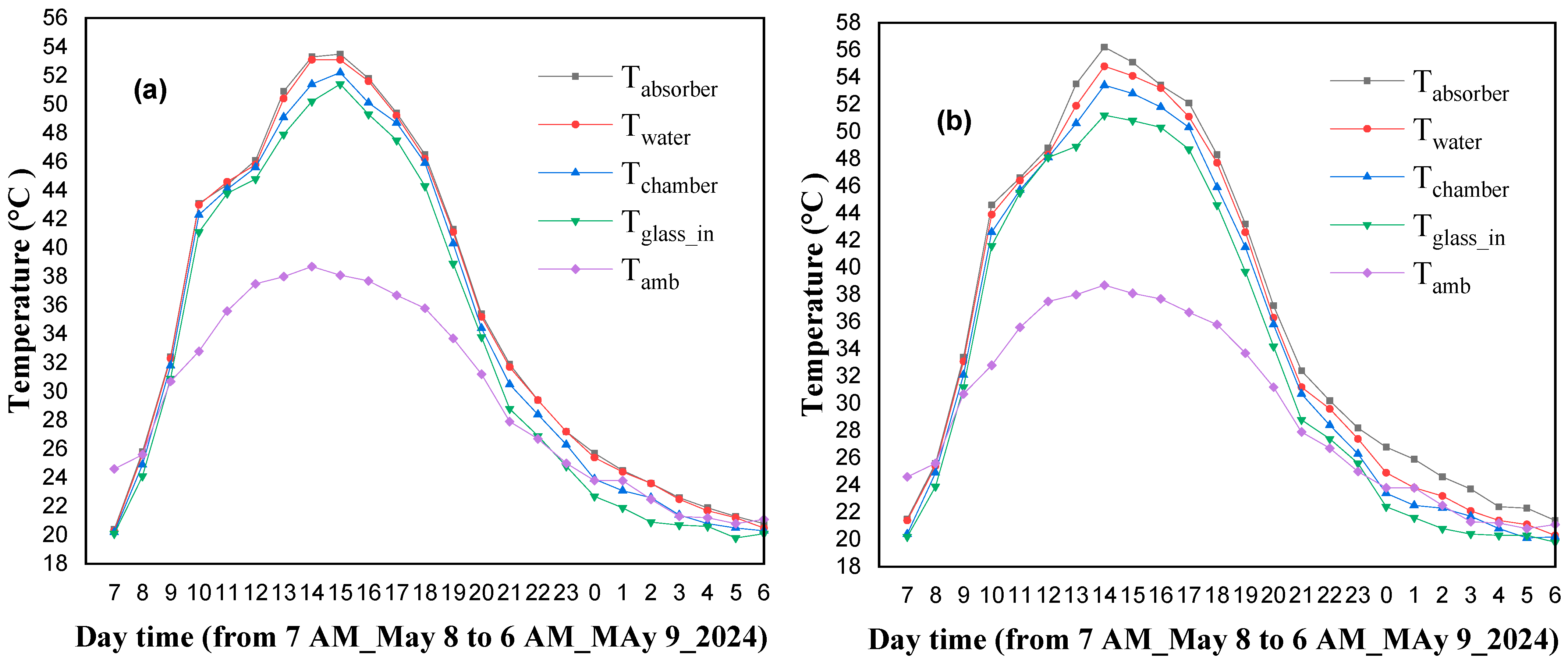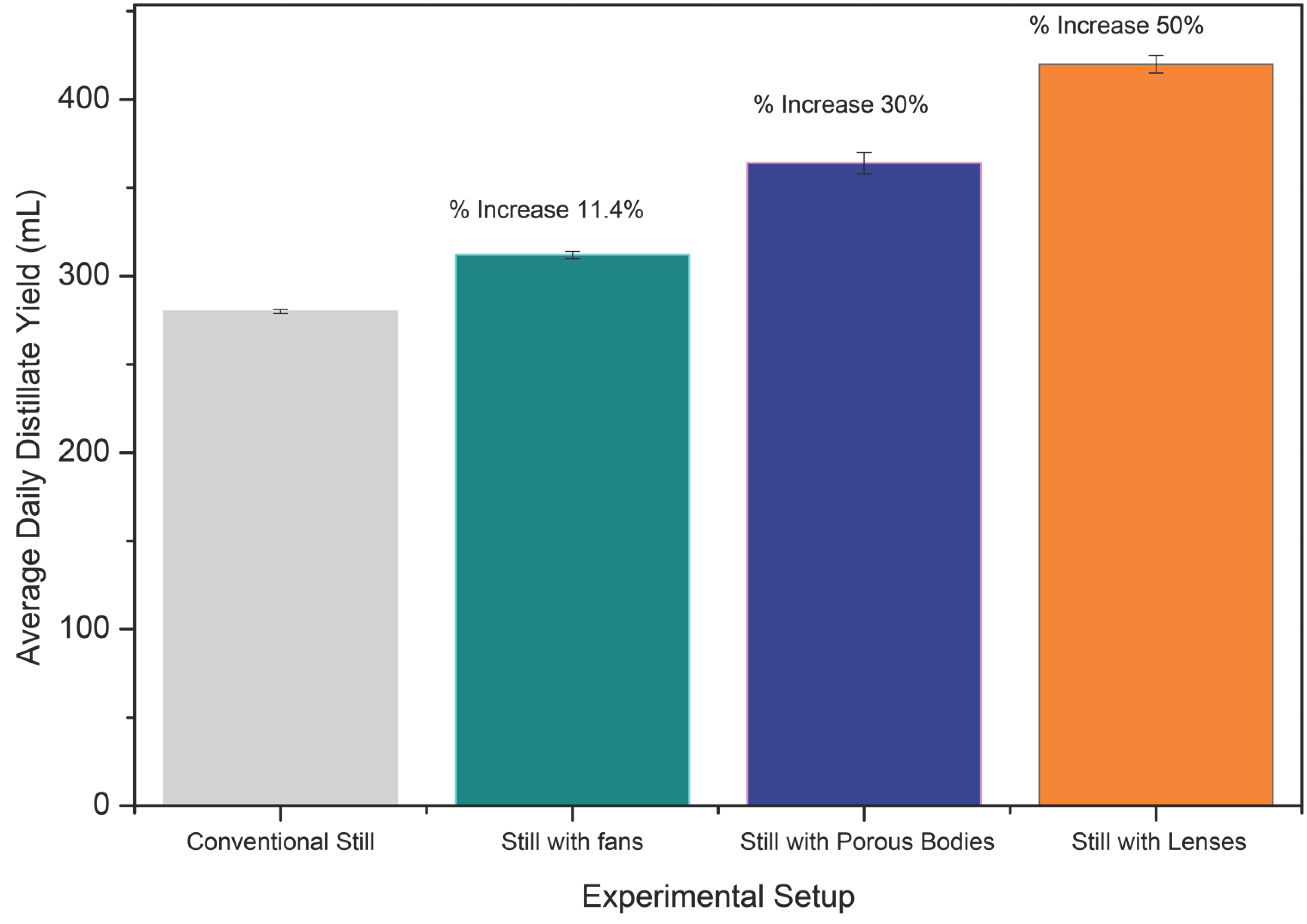Innovative Solar Still Desalination: Effects of Fans, Lenses, and Porous Materials on Thermal Performance Under Renewable Energy Integration
Abstract
1. Introduction
2. Materials and Methods
Real Climatic Conditions of Riyadh, Saudi Arabia
3. Results and Discussion
3.1. Effect of Using Fans to Enhance the Performance of the Solar Still
3.2. Effect of Using Porous Bodies to Enhance the Performance of the Solar Still
3.3. Effect of Using Lens to Enhance the Performance of the Solar Still
4. Conclusions
Author Contributions
Funding
Data Availability Statement
Conflicts of Interest
References
- Sathyamurt, R.; Samuel, D.G.H.; Nagarajan, P.K.; El-Agouz, S.A. A review of different solar still for augmenting fresh water yield. J. Environ. Sci. Technol. 2015, 8, 244–265. [Google Scholar] [CrossRef]
- Zayed, M.E. Recent Advances in Solar Thermal Selective Coatings for Solar Power Applications: Technology Categorization, Preparation Methods, and Induced Aging Mechanisms. Appl. Sci. 2024, 14, 8438. [Google Scholar] [CrossRef]
- Zhao, Y.; Ramadan, O.; Kong, H.; Xue, X.; Riffat, S.; Zheng, H. Performance analysis and optimization of a novel high-efficiency flower-inspired solar still. Energy Convers. Manag. 2022, 251, 114878. [Google Scholar] [CrossRef]
- Sharma, A.; Tyagi, V.V.; Chen, C.R.; Buddhi, D. Review on thermal energy storage with phase change materials and applications. Renew. Sustain. Energy Rev. 2009, 13, 318–345. [Google Scholar] [CrossRef]
- Alghassab, M.A. A review of hybrid solar desalination systems: Structure and performance. Water Sci. Technol. 2024, 89, 1357–1381. [Google Scholar] [CrossRef]
- Soltanian, M.; Hoseinzadeh, S.; Garcia, D.A. Proposal of a Reflector-Enhanced Solar Still Concept and Its Comparison with Conventional Solar Stills. Water 2024, 16, 355. [Google Scholar] [CrossRef]
- Malik, Y.A.-A.A.; Mohammad, O.A.A. Experimental investigation of the impact of water depth, inlet water temperature, and fins on the productivity of a Pyramid Solar Still. J. Groundw. Sci. Eng. 2023, 11, 183–190. [Google Scholar] [CrossRef]
- Suman, A.; Asthana, A.K. Advancements in Solar Still Designs: A Review of Optimization Strategies and Performance Factors. Smart Moves J. IJO-Science 2025, 11, 10–13. [Google Scholar] [CrossRef]
- Alwan, N.T.; Ali, B.M.; Alomar, O.R.; Abdulrazzaq, N.M.; Ali, O.M.; Abed, R.M. Performance of solar still units and enhancement techniques: A review investigation. Heliyon 2024, 10, e37693. [Google Scholar] [CrossRef]
- Kaviti, A.K.; Akkala, S.R.; Sikarwar, V.S.; Snehith, P.S.; Mahesh, M. Camphor-Soothed Banana Stem Biowaste in the Productivity and Sustainability of Solar-Powered Desalination. Appl. Sci. 2023, 13, 1652. [Google Scholar] [CrossRef]
- Kaviti, A.K.; Akkala, S.R.; Sikarwar, V.S. Productivity enhancement of stepped solar still by loading with magnets and suspended micro charcoal powder. Energy Sources Part A Recovery Util. Environ. Eff. 2021, 47, 2006371. [Google Scholar] [CrossRef]
- Omara, Z.; Ahmed, M.M.; Alawee, W.H.; Shanmugan, S.; Elashmawy, M. A comprehensive review of nano-enhanced phase change materials on solar stills with scientometric analysis. Results Eng. 2024, 22, 102088. [Google Scholar] [CrossRef]
- Yadav, P.; Singh, B.; Subedar; Kumar, S.; Singh, S.K. Performance Enhancement of a Hybrid Solar Still/Photovoltaic System with Mirror Reflectors, Automatic Water Cooling, and Feed Water Preheating. Russ. Phys. J. 2024, 67, 62–69. [Google Scholar] [CrossRef]
- Mcluret; Gnanaraj, S.J.P. Optimizing water purification in double slope solar stills using abc algorithm and machine learning techniques. Desalination Water Treat. 2025, 322, 101151. [Google Scholar] [CrossRef]
- Mahgoub, A.A.; Elsherbiny, S.M.; El-Masry, O.A.A.; Elsamni, O.A. Enhanced distillate production of stepped solar still via integration with multi-stage membrane distillation. Sci. Rep. 2025, 15, 12541. [Google Scholar] [CrossRef]
- Murali, G.; Ramani, P.; Murugan, M.; Elumalai, P.V.; Goud, N.U.R.; Prabhakar, S. Improved solar still productivity using PCM and nano-PCM composites integerated energy storage. Sci. Rep. 2024, 14, 15609. [Google Scholar] [CrossRef]
- Elsheikh, A.; Hammoodi, K.A.; Ibrahim, A.M.M.; Mourad, A.-H.I.; Fujii, M.; Abd-Elaziem, W. Augmentation and evaluation of solar still performance: A comprehensive review. Desalination 2024, 574, 117239. [Google Scholar] [CrossRef]
- Sharma, P.; Birla, S.K. Improving solar still efficiency with nanoparticles—Infused copper cylinders and latent heat storage: An experimental and simulation study. Appl. Therm. Eng. 2024, 243, 122650. [Google Scholar] [CrossRef]
- Abu-Zeid, M.A.-R.; Elhenawy, Y.; Toderas, M.; Bassyouni, M.; Majozi, T.; Al-Qabandi, O.A.; Kishk, S.S. Performance Enhancement of Solar Still Unit Using v-Corrugated Basin, Internal Reflecting Mirror, Flat-Plate Solar Collector and Nanofluids. Sustainability 2024, 16, 655. [Google Scholar] [CrossRef]
- Kasaeian, A.; Nazari, N.S.; Masoumi, A.; Shabestari, S.T.; Jadidi, M.; Fereidooni, L.; Bidhendi, M.E. A review on phase change materials in different types of solar stills. J. Energy Storage 2024, 99, 113430. [Google Scholar] [CrossRef]
- Kumar, N.; Kumar, A. Performance enhancement of conventional solar still using water depth variation and external reflector: An experimental study with energy, exergy, environ-economic analysis. J. Water Process. Eng. 2024, 68, 106460. [Google Scholar] [CrossRef]
- Barros, R.D.P. Design and implementation of an IoT monitoring system for the optimization of solar stills for water desalination. LatIA 2024, 2, 101. [Google Scholar] [CrossRef]
- Ahmed, M.M.; Younes, M.M.; Sharshir, S.W.; Elashmawy, M. The latest advances in solar still desalination systems: Analyzing different geometric configurations. Sol. Energy Mater. Sol. Cells 2025, 286, 113573. [Google Scholar] [CrossRef]
- Azari, P.; Lavasani, A.M.; Rahbar, N.; Yazdi, M.E. The effect of air flow on solar stills performance: A review. Desalination Water Treat. 2022, 256, 1–17. [Google Scholar] [CrossRef]
- Setareh, M.; Assari, M.R.; Tabrizi, H.B.; Alizadeh, M. Performance of a stepped solar still using porous materials experimentally. Environ. Dev. Sustain. 2023, 26, 28519–28538. [Google Scholar] [CrossRef]
- Abdelsalam, T.I.; Abdel-Mesih, B. An Experimental Study on the Effect of Using Fresnel Lenses on the Performance of Solar Stills. In International Congress on Energy Efficiency and Energy Related Materials (ENEFM2013); Springer: Cham, Switzerland, 2014; Chapter 45. [Google Scholar] [CrossRef]









| Experimental Setup | Mean Yield (mL) | Standard Deviation (SD) (mL) | % Increase over Conventional |
|---|---|---|---|
| Conventional Still | 280 | 1 | 0% |
| Still with Fans | 312 | 2 | 11.4% |
| Still with Porous Bodies | 364 | 6 | 30% |
| Still with Lenses | 420 | 5 | 50% |
| Method | Advantages | Limitations |
|---|---|---|
| Fans | Improved Airflow: By moving air around, fans can accelerate evaporation rates and aid in the still’s humidity removal. Cooling Effect: Fans can help improve condensation on the cover by moving air around the region of interest. Temperature Control: The temperature of the still can be regulated with the help of fans, especially in warm climates. Using fans increase the daily distillate water production by about 11%. | Energy Requirement: Fans may require electricity or another power source, which off-grid applications may not be able to provide. Maintenance: Over time, mechanical components may need to be replaced or wear out, which could lower reliability. |
| Porous bodies | Water Retention: Porous materials can absorb water and release it slowly, enhancing evaporation. Increased Surface Area: Efficiency may be improved by the porous structure’s wide surface area for evaporation. Thermal Properties: The ability of porous materials to retain heat raises the still’s overall temperature. Using porous bodies increase the daily distillate water production by about 30%. | Material Restrictions: Not all porous materials are appropriate since they have the potential to break down or release unwanted compounds into the distilled water. Weight and Handling: Certain porous bodies can be weighty or challenging to work with in a still. |
| Lenses | Solar energy concentration: Sunlight can be directed onto a still by lenses, which raises temperatures and greatly accelerates evaporation. Reduced Area Requirement: Lenses can increase the efficiency of smaller stills by concentrating sunlight. High Efficiency: In areas where sunshine is plentiful, using lenses can lead to extremely high evaporation rates. Using lenses increase the daily distillate water production by about 50%. | Complexity: Because lenses need to be installed and aligned precisely, their design and execution can be more complicated than other approaches. Cost and Accessibility: High-quality lenses may be more costly and not always easily accessible. |
Disclaimer/Publisher’s Note: The statements, opinions and data contained in all publications are solely those of the individual author(s) and contributor(s) and not of MDPI and/or the editor(s). MDPI and/or the editor(s) disclaim responsibility for any injury to people or property resulting from any ideas, methods, instructions or products referred to in the content. |
© 2025 by the authors. Licensee MDPI, Basel, Switzerland. This article is an open access article distributed under the terms and conditions of the Creative Commons Attribution (CC BY) license (https://creativecommons.org/licenses/by/4.0/).
Share and Cite
Choubani, K.; Ben Rabha, M. Innovative Solar Still Desalination: Effects of Fans, Lenses, and Porous Materials on Thermal Performance Under Renewable Energy Integration. Inventions 2025, 10, 109. https://doi.org/10.3390/inventions10060109
Choubani K, Ben Rabha M. Innovative Solar Still Desalination: Effects of Fans, Lenses, and Porous Materials on Thermal Performance Under Renewable Energy Integration. Inventions. 2025; 10(6):109. https://doi.org/10.3390/inventions10060109
Chicago/Turabian StyleChoubani, Karim, and Mohamed Ben Rabha. 2025. "Innovative Solar Still Desalination: Effects of Fans, Lenses, and Porous Materials on Thermal Performance Under Renewable Energy Integration" Inventions 10, no. 6: 109. https://doi.org/10.3390/inventions10060109
APA StyleChoubani, K., & Ben Rabha, M. (2025). Innovative Solar Still Desalination: Effects of Fans, Lenses, and Porous Materials on Thermal Performance Under Renewable Energy Integration. Inventions, 10(6), 109. https://doi.org/10.3390/inventions10060109





